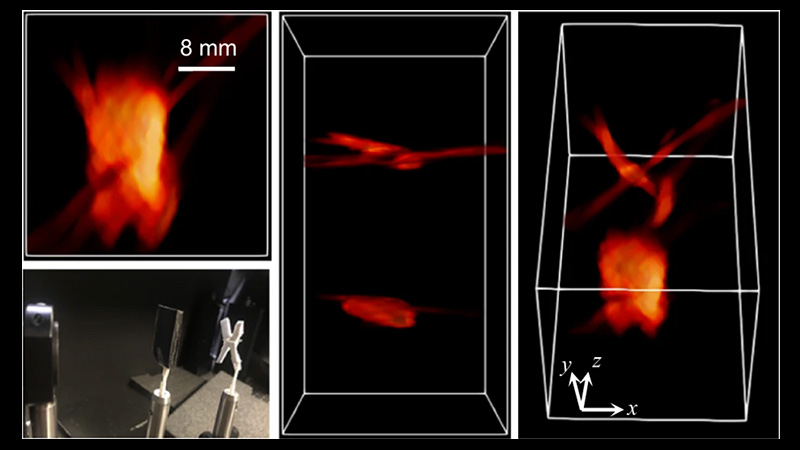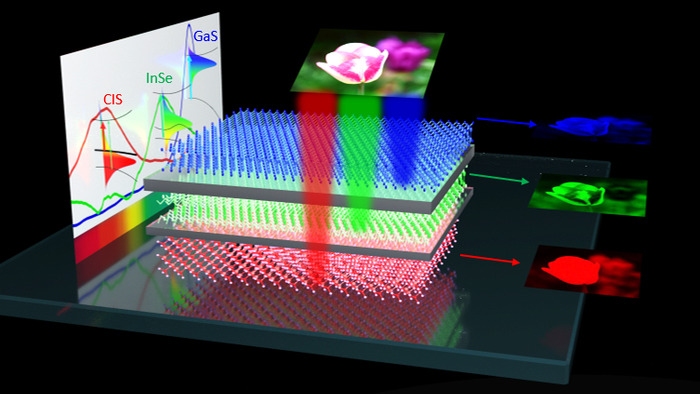
via UCLA Henry Samueli School of Engineering and Applied Science
A pair of UCLA bioengineers and a former postdoctoral scholar have developed a new class of bionic 3D camera systems that can mimic flies’ multiview vision and bats’ natural sonar sensing, resulting in multidimensional imaging with extraordinary depth range that can also scan through blind spots.
Powered by computational image processing, the camera can decipher the size and shape of objects hidden around corners or behind other items. The technology could be incorporated into autonomous vehicles or medical imaging tools with sensing capabilities far beyond what is considered state of the art today. This research has been published in Nature Communications.
In the dark, bats can visualize a vibrant picture of their surroundings by using a form of echolocation, or sonar. Their high-frequency squeaks bounce off their surroundings and are picked back up by their ears. The minuscule differences in how long it takes for the echo to reach the nocturnal animals and the intensity of the sound tell them in real time where things are, what’s in the way and the proximity of potential prey.
Many insects have geometric-shaped compound eyes, in which each “eye” is composed of hundreds to tens of thousands of individual units for sight — making it possible to see the same thing from multiple lines of sight. For example, flies’ bulbous compound eyes give them a near-360-degree view even though their eyes have a fixed focus length, making it difficult for them to see anything far away, such as a flyswatter held aloft.
Inspired by these two natural phenomena found in flies and bats, the UCLA-led team set out to design a high-performance 3D camera system with advanced capabilities that leverage these advantages but also address nature’s shortcomings.
“While the idea itself has been tried, seeing across a range of distances and around occlusions has been a major hurdle,” said study leader Liang Gao, an associate professor of bioengineering at the UCLA Samueli School of Engineering. “To address that, we developed a novel computational imaging framework, which for the first time enables the acquisition of a wide and deep panoramic view with simple optics and a small array of sensors.”
The researchers also use a type of LiDAR, or “Light Detection And Ranging,” in which a laser scans the surroundings to create a 3D map of the area.
Conventional LiDAR, without CLIP, would take a high-resolution snapshot of the scene but miss hidden objects, much like our human eyes would.
Using seven LiDAR cameras with CLIP, the array takes a lower-resolution image of the scene, processes what individual cameras see, then reconstructs the combined scene in high- resolution 3D imaging. The researchers demonstrated the camera system could image a complex 3D scene with several objects, all set at different distances.
“If you’re covering one eye and looking at your laptop computer, and there’s a coffee mug just slightly hidden behind it, you might not see it, because the laptop blocks the view,” explained Gao, who is also a member of the California NanoSystems Institute. “But if you use both eyes, you’ll notice you’ll get a better view of the object. That’s sort of what’s happening here, but now imagine seeing the mug with an insect’s compound eye. Now multiple views of it are possible.”
According to Gao, CLIP helps the camera array make sense of what’s hidden in a similar manner. Combined with LiDAR, the system is able to achieve the bat echolocation effect so one can sense a hidden object by how long it takes for light to bounce back to the camera.
Original Article: Bug Eyes and Bat Sonar: UCLA Bioengineers Turn to Animal Kingdom for Creation of Bionic Super 3D Cameras
More from: UCLA Henry Samueli School of Engineering and Applied Science
The Latest Updates from Bing News
Go deeper with Bing News on:
Bionic Super 3D Cameras
- Best Selling Phones (May 2024) in India
A ToF (Time-of-Flight) 3D ... LTPO Super Retina XDR OLED display with HDR10 certification. At its core is Apple’s in-house 4nm A16 Bionic SoC coupled with 6GB of RAM. There is a triple-camera ...
- Best mirrorless cameras in 2024
Knowing about the best mirrorless cameras has never been more important if you’re looking for a new camera. Most manufacturers (except Pentax) have ceased producing DSLRs, so you've really got ...
- What's the Best iPhone to Buy in 2024?
Apple sells many iPhones, and we've tested them all. Whether you need a superb camera, flagship power, or a simple first phone for your kids, here's how to choose the best iPhone. I’m PCMag’s ...
- iPad Vs. iPad Pro: Which One Should You Buy?
A pretty versatile, all-screen10.9-inch LiquidRetina display version of the iPad, perfectfor daily taskswith its A14 Bionic chip ... re into stuff like gaming, 3D modeling, or video editing.
- Best iPhone deals April 2024 UK; Get iPhone 15 for £41 per month
Both models have a new Super Retina XDR display ... TOF 3D LiDAR scanner. Dual front cameras: 12 MP wide and SL 3D depth/biometrics sensor. A14 Bionic chip, Qi fast wireless charging 15W, and ...
Go deeper with Bing News on:
Bionic 3D camera systems
- What I Love and What I Can’t Stand About the 2024 iPads
The latest iPads are strange beasts. Beyond the cheaper base iPad, you have the iPad Air and the iPad Pro. They’re both at the top of their game. They’re more powerful than ever, and the more ...
- iPhone 15 vs. iPhone 15 Pro: What are the differences?
The iPhone 15 Pro, without a doubt, is zippier and beastlier than the iPhone 15, thanks to its new A17 Pro Bionic chip. Meanwhile ... Plus, the iPhone 15 Pro has a better camera system. If taking ...
- Best Home Security Systems Of 2024
Commissions do not affect our editors' opinions or evaluations. Home security systems help keep your family and possessions safe while you’re home or away. The best home security systems provide ...
- Assistive Robotics Takes a Step Forward
Assistive robots are rapidly moving out of the lab and into everyday life. Equipped with machine vision, LiDAR, voice recognition, neuro-brain links and artificial intelligence (AI), they are taking ...
- Apple Event Live Blog: New iPad Pro, iPad Air, and More
Apple's "Let Loose" event kicks off today at the unusual time of 7:00 a.m. Pacific Time, and we're expecting to see an ...











